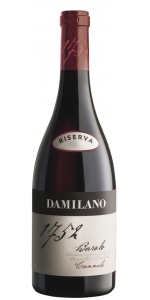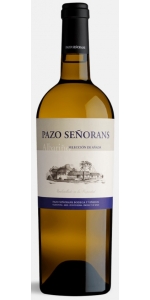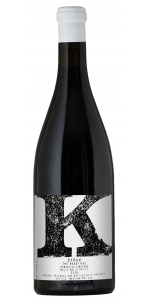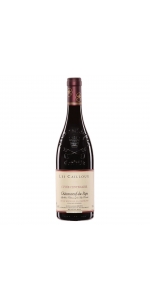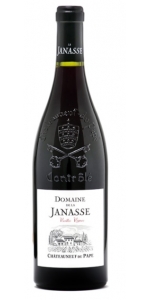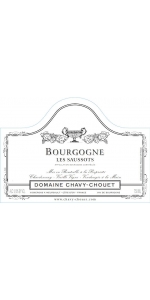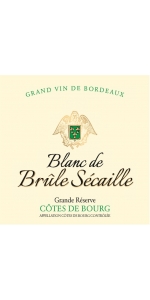Les Cailloux Blanc displays a pale gold color in its youth and evolves into deep gold after a few years of aging. It has floral scents of honeysuckle and jasmine with hints of honey. On the palate, white flowers and honey are joined by minerality and viscosity on the finish. The wine’s surprising complexity grows more well-rounded as it evolves in the glass.
Lucien et Andre Brunel Chateauneuf-du-Pape Les Cailloux Blanc 2021
6 bottles with free shipping for: $420.00
12 bottles with free shipping for: $780.00
| BUY MORE! SAVE MORE! | ||||||||||||||||||||
|
| Country: | France |
| Regions: | Rhone Chateauneuf du Pape |
| Winery: | André Brunel |
| Grape Type: | Roussanne |
| Organic: | Yes |
| Vintage: | 2021 |
| Bottle Size: | 750 ml |
Lucien et Andre Brunel Chateauneuf-du-Pape Les Cailloux Blanc is made from 70% Roussanne, 20% Grenache Blanc, 10% Clairette.
This historic estate was established in the 17th century when André Brunel’s family purchased a vineyard plot from the Bishop of Avignon. André took over the reins of this estate in 1971, and later his son Fabrice joined the winemaking team in 2012, keeping the family legacy alive by pursuing quality with the highest regard and respect for the environment.
Châteauneuf-du-Pape is notorious for its large, round pebbles that absorb the sun’s energy, radiating warmth throughout the night, allowing the grapes to achieve ideal ripeness and incredible complexity. “Les Cailloux” gets its name from the pebbles.
Review:
Inviting aromas of grapefruit and lime zest, Meyer lemon and honeydew harmonize with wild white flowers and stone on the nose. The palate is refreshed by brisk acidity, making way for a wave of fresh pears lemon zest, subtly framed by a layer of stone and light oak spice.
-Wine Enthusiast 96 Points
Our family has been in the Châteauneuf-du-Pape region since the 18th century and has been fully committed to making wine for five generations.
As of the 18th century, the wine-making activity of our family was testified by the purchase of a vineyard plot from the Bishop of Avignon to the north of the appellation.
Numerous generations followed on, all working in the vineyards but it was only in 1954 that Lucien Brunel created the name “Les Cailloux” to develop the business and promote the Domaine’s wine qualities and special characteristics. From that time one, it was referred to as the Domaine Les Cailloux.
In 1971, André Brunel took over the reins of the Domaine. His endless motivation resulted in a rapid growth for the Domaine: repurchasing of Côtes du Rhône and Vins de Pays vines, and launch of the infamous Centenary Cuvée in 1989. He also made some considerable changes in the vine management process by being one of the first people in Châteauneuf-du-Pape to use the ground covering method and to proceed with a non-chemical approach to wine-farming.
In 2012, his son, Fabrice Brunel, joined the team so the family history can continue.
The Estate is divided up into three appellations: Châteauneuf-du-Pape of course, but also Côtes du Rhône and Vaucluse Vins de Pays.
Our pursuit for quality, our utmost respect for the land and the drive to always provide our customers with wines they can enjoy throughout their ageing, impels us to be immeasurably meticulous during its production, regardless its appellation.
The differences are mainly the maturing times (longer for the Châteauneuf, and shorter for the Vins de Pays to make them available sooner) and the usage of vats (for Syrahs in Châteauneuf-du-Pape to mellow out the tannins, absent on the Côtes du Rhône and the Vins de Pays to maintain the fruits freshness).
We want to produce wines reflecting their region and origin while remaining elegant and wonderfully subtle.
Châteauneuf-du-Pape
The Domaine boasts 21 hectares under the Châteauneuf-du-Pape appellation, including 2 with whites, which are divided up into about ten segments. The largest are Farguerol to the north, Revès and Plan du Rhône to the south and Bois de la Ville at the top end of the village.
The soils vary with countless round pebbles but also sandy and clayey soils.
Ground topography: analysis of a segment with round pebbles
The “useful” layers for the vineyard are in tiers of about 3 metres:
- From 0 to 50 cm: mainly pebbles (80%) completed by sand. Large amount of roots.
- From 50 to 140 cm: large amount of pebbles (60%), the rest being mostly clay. A lot of fine roots and rootlets.
- From 140 to 300 cm: layer of accumulated clay but still with pebbles (about 20%).
Deep roots make it easier to trap water which is present over 2 metres under the surface and the pebbles reduce the evaporation due to heat or the Mistral. Therefore the plant is well hydrated even during hot summer weather.
Grape Varieties planted
The red grape varieties are mainly Grenache Noir, followed by Mourvèdre, Syrah and Cinsault:
- 70% of Grenaches, which, if harvested when very ripe, contribute to the strength, roundness and aromas of crushed red fruits,
- 17% of Mourvèdres which, planted in suitable soil (sandy clay) and harvested late, contribute to the structure of lively tannins, emphasizing the qualities of Grenache without making them denatured,
- 10% of Syrah which gives aromas of fresh black fruits and for amplified the colour,
- 3% of Cinsaults which gives a bit of lightness to the whole.
In white grapes, Roussanne dominates (85%) followed by White Grenache (15%).
“1752” is the name of the Damilano Barolo Cannubi Riserva, in honor of the year in which the historic bottle was first marked “Cannubi”. It still exists today perfectly conserved by the Manzone family in Bra, close to Barolo. The bottle is clearly marked as being of “1752” vintage, indicating that Cannubi historically precedes Barolo.
About the Vineyard:
The Cannubi Cru is in found within one of the 6 core zones which comprise a UNESCO heritage site in Italy. A mixture of Tortonian and Helvetian calcareous marl gives the grapes intense aromas of cherry, plum and tobacco, rose and violet in sequence. Its low potassium and high calcium/magnesium content offer the wine a fine and polished touch. The vineyard is located at about 270 m. a.s.l. and has a south-east sun exposure. Barolo Riserva Cannubi 1752 It is a small plot of about 2 hectares of Nebbiolo vines, currently between 30 and 50 years of age.
Tasting Notes:
Garnet ruby red in color, the bouquet is intense and balanced, with notes of violet, red fruit, cherry and plum, spices, liquorice, cocoa, leather and tobacco. Dry, robust, full-bodied, very persistent, rich and velvety
Food Pairing:
This wine is excellent with typical piedmontes pasta (tajarin, ravioli); perfect with red meat, braised and roast meat, game and absolutely ideal with all types of cheeses.
Review:
“Incredible, reserved ripeness and depth already evident on the nose after one whiff, offering plum, cedar, rose hip, sandalwood, and licorice. Full-bodied with superb depth of fruit and an abundance of polished tannins that give the wine poise and grace, even though it’s long and powerful. The quality of the tannins are exceptional. Sheer and refined. This comes from the center of Cannubi.”
-James Suckling 99 Points
Pazo de Senorans Seleccion de Anada Albarino is made from 100 percent Albarino.
Straw yellow with greenish tints, vivid and brilliant. High intensity and very expressive. Profusion of aromas with traces of mineral. Great volume and ample body leaving a lasting impression from beginning to end.
Reviews:
I think the 2014 Albariño Selección de Añada could be the finest vintage of this characterful long-aging Albariño, from a year with a more moderate 13% alcohol and very high acidity (and low pH) that make the wine fresher and more vibrant. It is developing very slowly and showing quite young after it spent over 30 months with lees in 1,500- and 3,000-liter stainless steel tanks. It has a pale color and an elegant nose with notes of freshly cut grass, white flowers and wet granite. The palate is vibrant with effervescent acidity, and it has a long, dry and tasty finish with an austere sensation, far away from the tropical notes of some past vintages. This is superb and should continue developing nicely in bottle. Bravo! It wasn't bottled until April 2023, and 14,000 bottles were produced.
-Wine Advocate 96 Points
Tech:
Charles Smith K Vintners Powerline Estate Syrah is made from 100 percent Syrah.
Friendly, approachable and vivacious, yet also dark and mysterious. Black cherry, allspice, black ash, and orange blossom. Thyme and flint with ark fruit, cedar, kelp, black pepper, juniper, crushed rock, and tons of complex floral notes. Fear not, embrace it.
While just bottled a week before this tasting, the 2019 Syrah Powerline Vineyard certainly wasn't showing any worse for it, offering a stunning bouquet of ripe red and black fruits as well as white pepper, sandalwood, tobacco, and new leather. Pure, medium to full-bodied, and vibrant, with supple, polished tannins, this brilliant Syrah is going to keep for 10-12 years, if not longer.
-Jeb Dunnuck 97 Points
“1752” is the name of the Damilano Barolo Cannubi Riserva, in honor of the year in which the historic bottle was first marked “Cannubi”. It still exists today perfectly conserved by the Manzone family in Bra, close to Barolo. The bottle is clearly marked as being of “1752” vintage, indicating that Cannubi historically precedes Barolo.
About the Vineyard:
The Cannubi Cru is in found within one of the 6 core zones which comprise a UNESCO heritage site in Italy. A mixture of Tortonian and Helvetian calcareous marl gives the grapes intense aromas of cherry, plum and tobacco, rose and violet in sequence. Its low potassium and high calcium/magnesium content offer the wine a fine and polished touch. The vineyard is located at about 270 m. a.s.l. and has a south-east sun exposure. Barolo Riserva Cannubi 1752 It is a small plot of about 2 hectares of Nebbiolo vines, currently between 30 and 50 years of age.
Tasting Notes:
Garnet ruby red in color, the bouquet is intense and balanced, with notes of violet, red fruit, cherry and plum, spices, liquorice, cocoa, leather and tobacco. Dry, robust, full-bodied, very persistent, rich and velvety
Food Pairing:
This wine is excellent with typical piedmontes pasta (tajarin, ravioli); perfect with red meat, braised and roast meat, game and absolutely ideal with all types of cheeses.
Review:
Lismore Chardonnay Reserve made from 100 percent Chardonnay.
A careful selection of the best of the vintage that exemplifies the extraordinary terroir of Lismore. This Reserve Chardonnay shows intense citrus, stone fruit, jasmine and walnut layered with honey and vanilla carried by a distinct minerality and crisp acidity with a lingering citrus finish.
Wine Made in the Soil
The vineyards are planted in decomposed shale over clay at 300 meters in the foothills of the Sonderend Mountain Range. A low mean February temperature lends to an extended ripening period that can put harvest 3-4 weeks later than traditional wine growing regions in South Africa. The intense citrus notes and the lingering finish are consistent trademarks of Lismore's specific terroir. The restrained minerality of the Chardonnay is a clear indication of the cool climate in which it is grown.
Wine of Origin "Greyton" has been designated by SAWIS recognizing the special terroir of this region.
Delightful with warm curries which lift the aromatics or a traditional pairing of smoked salmon highlighting the fresh acidity.
Review:
100% Chardonnay matured in Burgundian oak (33% new) for 11 months. This Reserve Chardonnay shows intense citrus, stone fruit, jasmine and walnut layered with honey and vanilla carried by a distinct minerality and crisp acidity with a lingering citrus finish.
-Karen McNeil 95 points
K Vintners The Beautiful Syrah 2018 is made from 97% Syrah, 3% Viognier.
A multi-layered beauty; perfumed, lovely. Super dark rose. Broken, unfiltered cigarette, Amaro. Densely colored with a shimmering red rim. Giving, yet just an inch at a time. One to ponder. One to enjoy.
Review:
The 2018 Syrah The Beautiful Powerline Vineyard comes from a vineyard outside of Walla Walla, in the foothills of the Blue Mountains. It was not destemmed and was brought up in neutral, larger barrels. An exotic nose of ripe blue and black fruits, lavender, sappy flowers, and herbes de Provence-like nuances give way to a medium to full-bodied, richly textured, structured wine with a mouth-filling, layered, meaty style that builds nicely with time in the glass. There's always a sappy, almost herbal edge to this beauty, and it ages beautifully. Feel free to open bottles any time over the coming 15-20 years. It would certainly be hard to pick out in a lineup of top Northern Rhône Syrahs.
-Jeb Dunnuck 97 Points
Review:
Lastly, and a wine that will be a candidate for perfection in 4-5 years, the 2019 Châteauneuf Du Pape Centenaire reveals a deep ruby/purple hue as well as extraordinary notes of black cherries, licorice, iron, nori, and peppery garrigue. As with the base 2019, the estate did an incredible job with the tannins, and this wine is flawlessly balanced, with ultra-fine tannins, no hard edges, and the sheer class to evolve for 25+ years. This is a perfect example of power with no sensation of weight or heaviness. The blend in 2019 is 84% Grenache, 10% Mourvèdre, and 6% Syrah, and it wasn’t destemmed and was brought up mostly in concrete tanks, with just 6% in very old barrels.
-Jeb Dunnuck 98 Points
Domaine de la Janasse Chateauneuf-du-Pape Cuvee Vieilles Vignes is made from 65% Grenache, 20% Mourvèdre, 10% Syrah, 5% divers.
In contrast to Chaupin, which is made from old-vine Grenache on sandy soils, the cuvée Vieilles Vignes is from old vines of Grenache, Mourvedre, Syrah along with smaller percentages of other permitted varieties that are grown in these old vineyards. The wine is sourced from 4 terroirs: pebbly clay, sand, gravelly red clay and sandy limestone. Vieilles Vignes is always the most powerful and concentrated Châteauneuf-du-Pape cuvée made at Domaine de la Janasse.
Review:
The advantages of old vines are perhaps most evident in the more difficult vintages (whether hot and dry or cool and rainy). The 2021 Chateauneuf du Pape Vieilles Vignes is a strong effort, delivering supple, velvety waves of ripe black cherries and black raspberries. Medium to full-bodied, it's rich and concentrated without seeming at all heavy or unbalanced, finishing long and juicy. It's approximately 75% Grenache, 15% Mourvèdre, 5% Syrah and 5% other varieties, keeping in mind that up to 15% of the old Grenache vines are actually Clairette Rose.
-Wine Advocate 96 Points
Barolet-Pernot Auxey-Duresses Blanc Les Clous is 100% Chardonnay.
A very bright color with some green reflections. On the nose we find a fresh and elegant wine with aromas of fruit and wood.
On the palate we have a round wine with a beautiful freshness and minerality.
Domaine Barolet-Pernot Pere et Fils is a small Estate located in Saint Romain. They currently have 14 hectares (34 acres).
Chavy-Chouet Bourgogne Blanc Les Saussots is made from 100 percent Chardonnay. A medium yellow straw color in the glass. On the nose, you will find layers aromas of cured lemon and hints of coconut and mango. On the palate, the juice has clean flavor, fresh acidity, and excellent balance. Vanilla notes follow through to the slightly creamy finish.
The grapes from this wines are grown from the Meursault area. (either outside of the AOC limit or with younger vines).
Seafood, fish, salad or by itself as an aperitif.
Drink this one now or over the next 3 to 4 years.
Chavy-Chouet Maranges Blanc Les Meurees is made from 100 percent Chardonnay.
Brulesecaille Blanc Grande Reserve is made from 75% Sauvignon Blanc, 25% Sauvignon Gris.
Average age of the vines is 25 years.
Manual harvest from September 19th-20th 2016.
Direct press at low pressure (whole cluster) with low amount of SO2, settling at 10°C.
Addition of yeast and alcoholic fermentation in casks 400 liters.
Raised on the lees for 6 months with regular batonnage (stirring of the lees).
Bottling in april 2017.
Fish, seafood, white meats, fine goat cheeses.
- back
Figgins Estate Red Wine is a blend of Cabernet Sauvignon, Petit Verdot & Merlot
Dark to the rim, with signature aromatic notes of ripe red and blue fruits, tanned leather, black olive, and lilac. The nose simply brings a smile. On the palate, if I had to describe the wine in one word it would be precision. The way the sweet fruit and dramatic length are braced by lively acidity and tannins aligns so perfectly that the wine is, quite simply, delicious.
Review:
Inviting aromas of vivid red fruit, fresh herbs and paprika. Full-bodied with juicy, fruit-soaked, fine tannins. Delightful. So much happening here. The fruit is plentiful and full of charming spice and herbal complexity. Very well balanced and long. Fresh. A blend of cabernet sauvignon, merlot and petit verdot. Best after 2024 but attractive now.
-James Suckling 96 Points
Oumsiyat Chardonnay is made from 100 percent Chardonnay.
Intense aromas of luscious tropical fruit notes of ripe peach and pineapple are refreshingly balanced on the palate through to a clean and zesty finish.
RS: 2 g/L
The Chardonnay grapes were sorted prior to vinification to ensure the fruit was healthy and ripe. The grapes were then pressed, and the must was racked to stainless steel fermentation tanks, where the must was fermented at 14 to 16°C with selected yeasts. The wine did not undergo malolactic fermentation to maintain the crisp, fresh style. The wine rested on its fine lees for three months adding texture and subtle complexity before being gently filtered and bottled.


